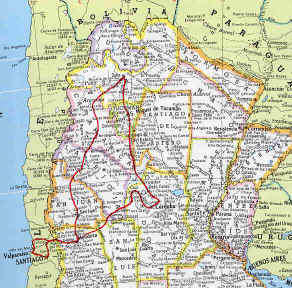
This was a 3,500 kilometer loop ride beginning and ending in Santiago, Chile. After crossing the Andes by bus at Los Andes, we cycled north along Route 40 through the desolate high desert (known in Argentina as the Monte) to Salta, near the Bolivian border. This route paralleled the Andes and we had 5,000+ meter mountains on our left the entire way. We then turned southeast through a bit of the Chaco thorn forest and the pampas to Argentinaís second city, Cordoba. From there we continued west to Mendoza and then re-crossed the Andes back to Chile. We spent a few days cycling on the coast through Vina del Mar and Valparaiso before returning to Santiago.
Personal
Highlights
Cycling Conditions
Climate
Accommodations
Problems
Photographs
Home
One of the highlights was free camping for several nights in dry riverbeds at the base of the Andes. These campsites were usually far from any settlements - on a couple of nights we were more than 80 kilometers from the nearest person. In this isolated setting, it was truly sublime to watch the sun set over the Andes. Another highlight was being invited to an asado (an Argentine barbecue) and being able to drink mate with our newfound friends, Pablo and Amanda, in Cordoba. It was a highlight as well to just experience the exuberance and hospitality of the Argentine people. Their "live and let live" attitude was really refreshing.
As a rule, the Argentine roads did not have shoulders and so could be dangerous in more heavily traveled rural areas. Surprisingly, the streets in crowded urban areas were relatively safe because they were usually wide with one way traffic. We biked primarily on Route 40 from Mendoza to Salta. Apart from the 100 kilometers or so entering or leaving each of these cities, this road had very light traffic (in some of the more isolated areas fewer than 10 cars passed the entire day). About 200 kilometers of this stretch were gravel or sand, with the sand portions being problematic. It took us two days (17 hours of hard cycling) to do one eighty kilometer stretch of sand road.
After Salta we took the main road to Cordoba (there was no other choice) and it was not particularly pleasant cycling due to the heavy traffic. We were constantly jumping on and off the pavement to allow trucks to pass. We had mirrors, and I canít imagine doing this stretch without them. From Cordoba to Mendoza we had more choices and were able to find more pleasant cycling roads.
The Argentine drivers are notoriously reckless and take some unbelievable risks. However, they were good with cyclists and always gave us as much room as possible. In fact, the thing that worried us the most was when trucks or buses would pass us all the way over in the other lane on blind curves.
Despite the fact that we were traveling in mid-winter (June-August) we had very pleasant cycling weather for the entire trip. In Argentina we had sunny weather almost every day with high temperatures usually around 20 degrees centigrade. The evenings, however, were another story as the temperature when we were at elevation would drop below freezing. We woke up several mornings with frozen water in our bottles. At lower elevation such as in Cordoba and Tucuman the nights would drop to about 5 degrees and days were about 25 degrees. We had no rain and only two days of light drizzle the entire trip.
Argentina has a lot of campgrounds but most were closed in the winter so we free camped about 1/3 of the time. This was quite easy to do in the desert but was a little more problematic on the more developed pampas near Cordoba. Usually when we arrived in a city or town of any size we would stay in hotels, which were plentiful and cheap - $15 could usually get us a clean room with private bath and satellite tv in any of the smaller towns or cities. The biggest problem with hotels in the smaller towns was the local dogs that would bark all night long. I would strongly recommend earplugs for anyone staying in these towns.
Apart from some of the cycling on narrow, heavily trafficked roads, we never felt in danger in either country and believe they are probably as safe to cycle in as the US or Europe. We were warned about muggers and thieves in Cordoba and Tucuman but did not have any problems. Dogs were everywhere but rarely bothered cyclists. The biggest problem with the dogs was the all night howling. Language could be a problem if you do not speak any Spanish.